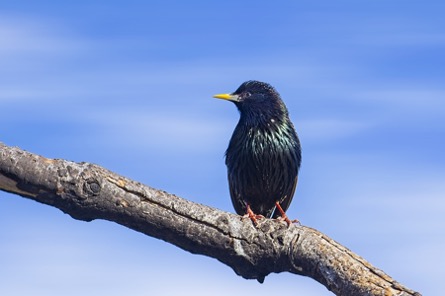Bird Basics: Get to Know the European Starling
Oct 17, 2023
With its highly iridescent, speckled coat of feathers, bright yellow bill, and pink feet, the European Starling is an easily recognizable bird. These highly athletic birds can often be found flying in-sync in flocks numbering the tens of thousands, dancing in the sky as part of a murmuration.
Distinct features and athleticism aside, starlings are perhaps best known for their intelligence and incredible mimicry abilities. They are such good mimics, in fact, they have been known to imitate noises as complex as human speech, musical instruments, electrical sounds, and other species of birds, including the iconic scream of a red-tailed hawk. Their superlative skills are put prominently on display during mating season: instead of singing a single song (as is customary among most species), starlings attract mates by performing symphonies of diverse mimicked sounds and songs.
Despite their beauty and intelligence, starlings have been known to cause an outsized amount of damage – to farms and airfields, in particular.
The Dangers Posed by Starlings
Starlings are a highly invasive species, hailing from Europe and not native the New World. They evolved alongside humans for thousands of years and are extremely well-adapted to living in populated urban and suburban areas. Because starlings are comfortable living among humans, they frequently nest in and around homes and buildings. They are experts at finding tiny nooks and crannies to shove nesting material into, which can create fire hazards and damage structures.

In addition to harming buildings, starlings have no qualms about killing other birds and their chicks and destroying eggs to take over a nesting cavity; they are incredibly aggressive and territorial nesters. This combative behavior has contributed to the decline of native species like woodpeckers, purple martins, tree swallows, bluebirds, chickadees, and more, who have not evolved to deal with such aggressive competition. Starlings have also been known to bully other birds away from bird feeders and bird houses.
Starlings’ Impact on Agriculture & Aviation
Starlings hit farms – and livestock farms, in particular – tremendously hard. When starlings infiltrate a farm, they eat large amounts of livestock feed, often picking and choosing the most nutritious and highest protein parts. Their droppings then contaminate the rest of the feed, making it unsuitable for the livestock and risking the spread of diseases like transmissible gastroenteritis (TGE), E. coli, campylobacter, Johne’s disease, and salmonella. One study that investigated the impact starlings had on dairy farms in Washington state, found the birds caused an average feed loss of $55 per cow annually, which amounts to millions of dollars in losses across the state each year.
Starlings can also create a huge risk for airports: their murmurations have the power to take down airplanes. If a small jet engine ingests just eight starlings, the engine could fail. And, while a collision of this type may seem like an unlikely scenario, starlings have been responsible for fatal accidents. In 1960, a murmuration of starlings was sucked into a plane’s engine, causing it to crash and killing 62 people. It was the deadliest bird-related plane crash that’s ever been reported.

How to Control Harmful & Aggressive Starlings
Unlike most birds, starlings are not a protected species in the U.S., which means many deterrence solutions may be employed.
The correct solution will vary based on the property and behavior of starlings, but common strategies include laser harassment (handheld or autonomic), netting, nest removal, and various structural repair and exclusion techniques that keep starlings out of and away from buildings.
The Wild Goose Chase team has extensive experience managing starlings in a variety of settings, including farms and airfields. With over 25 years of experience, we will be able to determine the appropriate solution for your starling conflict, based on your unique needs.
For more information, or to schedule a site evaluation, contact us.




 0
0
